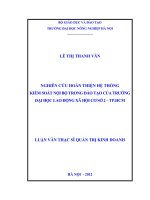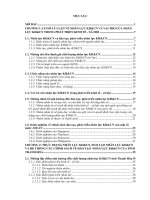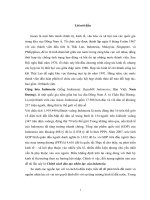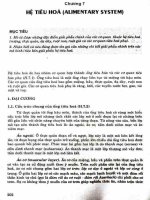Kỹ thuật truyền động thủy lực DIDATIC của hãng FESTO (Đức)
Bạn đang xem bản rút gọn của tài liệu. Xem và tải ngay bản đầy đủ của tài liệu tại đây (8.39 MB, 236 trang )
Textbook TP 501
Festo Didactic
093281 en
Hydraulics
Basic Level
093281_cover_textbook_tp501_en.indd 1 11.04.2005 17:00:09
Order No.: 093281
Description: HYDRAUL.LEHRB
Designation: D:LB-TP501-1-GB
Edition: 11/2003
Author: D. Merkle, B.Schrader, M. Thomes
Graphics: D. Schwarzenberger
Layout: 25.11.2003, M. Göttfert, G. Heigl, W. Schreiner
© Festo Didactic GmbH & Co. KG, 73770 Denkendorf/Germany, 2003
Internet: www.festo.com/didactic
e-mail:
The copying, distribution and utilization of this document as well as the
communication of its contents to others without expressed authorization is
prohibited. Offenders will be held liable for the payment of damages. All rights
reserved, in particular the right to carry out patent, utility model or ornamental
design registration.
Table of contents
1 Tasks of a hydraulic installation __________________________________ 7
1.1 Stationary hydraulics____________________________________________ 8
1.2 Mobile hydraulics _____________________________________________ 10
1.3 Comparison of hydraulics with other control media __________________ 11
2 Fundamental physical principles of hydraulics _____________________ 13
2.1 Pressure _____________________________________________________ 13
2.2 Pressure transmission__________________________________________ 18
2.3 Power transmission ____________________________________________ 19
2.4 Displacement transmission _____________________________________ 21
2.5 Pressure transfer ______________________________________________ 23
2.6 Flow rate_____________________________________________________ 25
2.7 Continuity equation____________________________________________ 26
2.8 Pressure measurement _________________________________________ 30
2.9 Temperature measurement______________________________________ 31
2.10 Measurement of flow rate _______________________________________ 31
2.11 Types of flow _________________________________________________ 31
2.12 Friction, heat, pressure drop ____________________________________ 35
2.13 Energy and power _____________________________________________ 41
2.14 Cavitation____________________________________________________ 51
2.15 Throttle points ________________________________________________ 53
3 Hydraulic fluid________________________________________________ 57
3.1 Tasks for hydraulic fluids _______________________________________ 57
3.2 Types of hydraulic fluid _________________________________________ 58
3.3 Characteristics and requirements_________________________________ 59
3.4 Viscosity_____________________________________________________ 60
4 Components of a hydraulic system _______________________________ 67
4.1 Power supply section __________________________________________ 67
4.2 Hydraulic fluid ________________________________________________ 67
4.3 Valves_______________________________________________________ 68
4.4 Cylinders (linear actuators)______________________________________ 70
4.5 Motors (rotary actuators) _______________________________________ 71
© Festo Didactic GmbH & Co. KG • TP 501
3
Table of contents
5 Graphic and circuit symbols_____________________________________ 73
5.1 Pumps and motors_____________________________________________ 73
5.2 Directional control valves _______________________________________ 74
5.3 Methods of actuation __________________________________________ 75
5.4 Pressure valves _______________________________________________ 76
5.5 Flow control valves ____________________________________________ 78
5.6 Non-return valves _____________________________________________ 79
5.7 Cylinders ____________________________________________________ 80
5.8 Transfer of energy and conditioning of the pressure medium __________ 82
5.9 Measuring devices_____________________________________________ 83
5.10 Combination of devices_________________________________________ 83
6 Design and representation of a hydraulic system ___________________ 85
6.1 Signal control section __________________________________________ 86
6.2 Hydraulic power section ________________________________________ 87
6.3 Positional sketch ______________________________________________ 90
6.4 Circuit diagram________________________________________________ 91
6.5 Components plus technical data__________________________________ 92
6.6 Function diagram______________________________________________ 94
6.7 Function chart ________________________________________________ 95
7 Components of the power supply section __________________________ 97
7.1 Drive ________________________________________________________ 97
7.2 Pump _______________________________________________________ 99
7.3 Coupling ____________________________________________________ 107
7.4 Reservoir ___________________________________________________ 107
7.5 Filters ______________________________________________________ 109
7.6 Coolers _____________________________________________________ 120
7.7 Heaters_____________________________________________________ 122
8 Valves______________________________________________________ 123
8.1 Nominal sizes________________________________________________ 123
8.2 Design _____________________________________________________ 125
8.3 Poppet valves________________________________________________ 126
8.4 Spool valves_________________________________________________ 127
8.5 Piston overlap _______________________________________________ 129
8.6 Control edges________________________________________________ 134
4
© Festo Didactic GmbH & Co. KG • TP 501
Table of contents
9 Pressure valves ______________________________________________ 137
9.1 Pressure relief valves _________________________________________ 137
9.2 Pressure regulators ___________________________________________ 144
10 Directional control valves______________________________________ 149
10.1 2/2-way valve _______________________________________________ 153
10.2 3/2-way valve _______________________________________________ 157
10.3 4/2-way valve _______________________________________________ 159
10.4 4/3-way valve _______________________________________________ 162
11 Non-return valves ____________________________________________ 167
11.1 Non-return valve _____________________________________________ 168
11.2 Piloted non-return valve _______________________________________ 172
11.3 Piloted double non-return valve _________________________________ 175
12 Flow control valves ___________________________________________ 179
12.1 Restrictors and orifice valves ___________________________________ 180
12.2 One-way flow control valve _____________________________________ 184
12.3 Two-way flow control valve_____________________________________ 185
13 Hydraulic cylinders___________________________________________ 193
13.1 Single-acting cylinder _________________________________________ 194
13.2 Double-acting cylinder ________________________________________ 196
13.3 End position cushioning _______________________________________ 199
13.4 Seals_______________________________________________________ 200
13.5 Types of mounting____________________________________________ 202
13.6 Venting _____________________________________________________ 202
13.7 Characteristics _______________________________________________ 203
13.8 Buckling resistance ___________________________________________ 205
13.9 Selecting a cylinder ___________________________________________ 207
14 Hydraulic motors_____________________________________________ 211
© Festo Didactic GmbH & Co. KG • TP 501
5
Table of contents
15 Accessories _________________________________________________ 215
15.1 Flexible hoses _______________________________________________ 217
15.2 Pipelines____________________________________________________ 223
15.3 Sub-bases __________________________________________________ 226
15.4 Bleed valves_________________________________________________ 228
15.5 Pressure gauges _____________________________________________ 229
15.6 Pressure sensors _____________________________________________ 230
15.7 Flow measuring instruments____________________________________ 231
16 Appendix ___________________________________________________ 233
6
© Festo Didactic GmbH & Co. KG • TP 501
1. Tasks of a hydraulic installation
Hydraulic systems are used in modern production plants and manufacturing
installations.
By hydraulics, we mean the generation of forces and motion using hydraulic fluids.
The hydraulic fluids represent the medium for power transmission.
The object of this book is to teach you more about hydraulics and its areas of
application. We will begin with the latter by listing the main areas for the application
of hydraulics.
The place held by hydraulics in (modern) automation technology illustrates the wide
range of applications for which it can be used. A basic distinction is made between:
• stationary hydraulics
• and mobile hydraulics
Mobile hydraulic systems move on wheels or tracks, for example, unlike stationary
hydraulic systems which remain firmly fixed in one position. A characteristic feature
of mobile hydraulics is that the valves are frequently manually operated. In the case
of stationary hydraulics, however, mainly solenoid valves are used.
Other areas include marine, mining and aircraft hydraulics. Aircraft hydraulics
assumes a special position because safety measures are of such critical importance
here. In the next few pages, some typical examples of applications are given to
clarify the tasks which can be carried out using hydraulic systems.
What do we mean
by hydraulics?
© Festo Didactic GmbH & Co. KG • TP 501
7
1. Tasks of a hydraulic installation
The following application areas are important for stationary hydraulics:
• Production and assembly machines of all types
• Transfer lines
• Lifting and conveying devices
• Presses
• Injection moulding machines
• Rolling lines
• Lifts
Machine tool construction is a typical application area.
Lathe
In modern CNC controlled machine tools, tools and work pieces are clamped by
means of hydraulics. Feed and spindle drives may also be effected using hydraulics.
1.1
Stationary hydraulics
8
© Festo Didactic GmbH & Co. KG • TP 501
1. Tasks of a hydraulic installation
Press with elevated reservoir
© Festo Didactic GmbH & Co. KG • TP 501
9
1. Tasks of a hydraulic installation
Typical application fields for mobile hydraulics include:
• Construction machinery
• Tippers, excavators, elevating platforms
• Lifting and conveying devices
• Agricultural machinery
There is a wide variety of applications for hydraulics in the construction machinery
industry. On an excavator, for example, not only are all working movements (such as
lifting, gripping and swivelling movements) generated hydraulically, but the drive
mechanism is also controlled by hydraulics. The straight working movements are
generated by linear actuators (cylinders) and the rotary movements by rotary
actuators (motors, rotary drives).
Mobile hydraulics
1.2
Mobile hydraulics
10
© Festo Didactic GmbH & Co. KG • TP 501
1. Tasks of a hydraulic installation
There are other technologies besides hydraulics which can be used in the context of
control technology for generating forces, movements and signals:
• Mechanics
• Electricity
• Pneumatics
It is important to remember here that each technology has its own preferred
application areas. To illustrate this, a table has been drawn up on the next page
which compares typical data for the three most commonly used technologies –
electricity, pneumatics and hydraulics.
This comparison reveals some important advantages of hydraulics:
• Transmission of large forces using small components, i.e. great
power intensity
• Precise positioning
• Start-up under heavy load
• Even movements independent of load, since liquids are scarcely
compressible and flow control valves can be used
• Smooth operation and reversal
• Good control and regulation
• Favourable heat dissipation
Compared to other technologies, hydraulics has the following disadvantages:
• Pollution of the environment by waste oil (danger of fire or accidents)
• Sensitivity to dirt
• Danger resulting from excessive pressures (severed lines)
• Temperature dependence (change in viscosity)
• Unfavourable efficiency factor
1.3
Comparison of hydraulics
with other control media
© Festo Didactic GmbH & Co. KG • TP 501
11
1. Tasks of a hydraulic installation
Electricity Hydraulics Pneumatics
Leakage Contamination No disadvantages apart from
energy loss
Environmental
influences
Risk of explosion in certain areas,
insensitive to temperature.
Sensitive in case of temperature
fluctuation, risk of fire in case of
leakage.
Explosion-proof,
insensitive to temperature.
Energy storage Difficult, only in small quantities
using batteries.
Limited, with the help of gases. Easy
Energy transmission Unlimited with power loss. Up to 100 m,
flow rate v = 2 – 6 m/s,
signal speed up to 1000 m/s.
Up to 1000 m,
flow rate v = 20 – 40 m/s,
signal speed 20 – 40 m/s.
Operating speed v = 0.5 m/s v = 1.5 m/s
Low High Very high Power supply costs
0.25 : 1 : 2.5
Linear motion Difficult and expensive, small
forces, speed regulation only
possible at great cost
Simple using cylinders, good speed
control, very large forces.
Simple using cylinders, limited
forces, speed extremely, load-
dependent.
Rotary motion Simple and powerful. Simple, high turning moment, low
speed.
Simple, inefficient, high speed.
Positioning accuracy Precision to ±1 µm and easier to
achieve
Precision of up to ±1 µm can be
achieved depending on
expenditure.
Without load change precision of
1/10 mm possible.
Stability Very good values can be achieved
using mechanical links.
High, since oil is almost
incompressible, in addition, the
pressure level is considerably
higher than for pneumatics.
Low, air is compressible.
Forces Not overloadable.
Poor efficiency due to downstream
mechanical elements.
Very high forces can be realized.
Protected against overload, with
high system pressure of up to 600
bar, very large forces can be
generated F < 3000 kN.
Protected against overload,
forces limited by pneumatic
pressure and cylinder diameter
F < 30 kN at 6 bar.
12
© Festo Didactic GmbH & Co. KG • TP 501
Hydraulics is the science of forces and movements transmitted by means of liquids.
It belongs alongside hydro-mechanics. A distinction is made between hydrostatics –
dynamic effect through pressure times area – and hydrodynamics – dynamic effect
through mass times acceleration.
Hydro-mechanics
Hydrostatic pressure is the pressure which rises above a certain level in a liquid
owing to the weight of the liquid mass:
p
T
s
T
= h ⋅ ρ ⋅ g
p
T
s
T
= hydrostatic pressure (gravitational pressure) [Pa]
h = level of the column of liquid [m]
ρ = density of the liquid [kg/m
T
3
T
]
g = acceleration due to gravity [m/s
T
2
T
]
In accordance with the SI international system of units, hydrostatic pressure is given
in both Pascal and bar. The level of the column of liquid is given the unit “metre”,
the density of the liquid “kilograms per cubic metre” and the acceleration due to
gravity “metres per second squared”.
2. Fundamental physical principles of hydraulics
2.1
Pressure
Hydrostatic pressure
© Festo Didactic GmbH & Co. KG • TP 501
13
2. Fundamental physical principles of hydraulics
The hydrostatic pressure, or simply “pressure” as it is known for short, does not
depend on the type of vessel used. It is purely dependent on the height and density
of the column of liquid.
Hydrostatic pressure
Column: h = 300 m
ρ = 1000 kg/m
T
3
T
g = 9.81 m/s
T
2
T
= 10 m/s
T
2
T
p
T
S
T
= h ⋅ ρ ⋅ g = 300 m ⋅ 1000
3
m
kg
⋅ 10
2
s
m
= 3 000 000
23
sm
mkgm
⋅
⋅⋅
= 3 000 000
2
m
N
p
T
S
T
= 3 000 000 Pa = 30 bar
Reservoir: h = 15 m
ρ = 1000 kg/m
T
3
T
g = 9.81 m/s
T
2
T
= 10 m/s
T
2
T
p
T
S
T
= h ⋅ ρ ⋅ g = 15 m ⋅ 1000
3
m
kg
⋅ 10
2
s
m
= 150 000
23
sm
mkgm
⋅
⋅⋅
= 150 000
2
m
N
p
T
S
T
= 150 000 Pa = 1,5 bar
Elevated tank: h = 5 m
ρ = 1000 kg/m
T
3
T
g = 9.81 m/s
T
2
T
= 10 m/s
T
2
T
p
T
S
T
= h ⋅ ρ ⋅ g = 5 m ⋅ 1000
3
m
kg
⋅ 10
2
s
m
= 50 000
23
sm
mkgm
⋅
⋅⋅
= 50 000
2
m
N
p
T
S
T
= 50 000 Pa = 0,5 bar
14
© Festo Didactic GmbH & Co. KG • TP 501
2. Fundamental physical principles of hydraulics
Every body exerts a specific pressure p on its base. The value of this pressure is
dependent on the force due to weight F of the body and on the size of the area A on
which the force due to weight acts.
A
1
A
2
F
F
Force, area
The diagram shows two bodies with different bases (A
T
1
T
and A
T
2
T
). Where the bodies
have identical mass, the same force due to weight (F) acts on the base. However, the
pressure is different owing to the different sizes of base. Where the force due to
weight is identical, a higher pressure is produced in the case of a small base than in
the case of a larger base (“pencil” or “concentrated” effect).
This is expressed by the following formula:
A
F
p =
Unit: 1 Pa = 1
2
m
N
2
m
N
1 bar = 100 000
= 10
T
5
T
Pa
p = Pressure Pascal [Pa]
F = Force Newton [N] 1 N = 1
2
s
mkg ⋅
A = Area Square metre [m
T
2
T
]
Rearrangement of the formula produces the formulae for calculating force and area:
© Festo Didactic GmbH & Co. KG • TP 501
15
2. Fundamental physical principles of hydraulics
A cylinder is supplied with 100 bar pressure, its effective piston surface is equal to
7.85 cm
T
2
T
. Find the maximum force which can be attained.
Given that: p = 100 bar = 1000 N/cm
T
2
T
A = 7.85 cm
T
2
T
F = p ⋅ A =
2
2
cm
cm85.7N1000 ⋅
= 7850 N
A lifting platform is to lift a load of 15 000 N and is to have a system pressure of
75 bar.
How large does the piston surface A need to be?
Given that: F = 15 000 N
P = 75 bar = 75 ⋅ 10
T
5
T
Pa
N
mN
002.0
Pa1075
N00015
p
F
A
2
5
⋅
=
⋅
==
= 0.002 m
T
2
T
= 20 cm
T
2
T
Instead of making calculations it is possible to work with a diagram. The stiction in
the cylinder is not taken into consideration.
Given that: Force F = 100 kN
Operating pressure p = 350 bar.
What is the piston diameter?
Reading: d = 60 mm
Example
Example
Example
16
© Festo Didactic GmbH & Co. KG • TP 501
2. Fundamental physical principles of hydraulics
2.5
3
4
5
6
7
8
9
10
15
20
30
40
50
60
70
80
90
100
150
200
300
400
500
600
700
800
900
1000
1500
2000
3000
kN
Force
10
15
20
25
30
40
50
60
70
80
90
100
150
200
250
mm
400
Piston diameter
350 bar
300 bar
200 bar
160 bar
125 bar
100 bar
80 bar
50 bar
(5000 kPa)
Piston diameter, force and pressure
© Festo Didactic GmbH & Co. KG • TP 501
17
2. Fundamental physical principles of hydraulics
If a force F
T
1
T
acts via an area A
T
1
T
on an enclosed liquid, a pressure p is produced which
extends throughout the whole of the liquid (Pascal’s Law). The same pressure
applies at every point of the closed system (see diagram).
Pressure transmission
Owing to the fact that hydraulic systems operate at very high pressures, it is
possible to neglect the hydrostatic pressure (see example). Thus, when calculating
the pressure in liquids, the calculations are based purely on pressure caused by
external forces. Thus, the same pressure acts on the surfaces A
T
2
T
, A
T
3
T
as on A
T
1
T
. For
solid bodies, this is expressed by means of the following formula:
A
F
p =
Given that: A
T
1
T
= 10 cm
T
2
T
= 0.001 m
T
2
T
F = 10 000 N
22
m
N
00000010
m001.0
N00010
A
F
p ===
= 100 ⋅ 10
T
5
T
Pa (100 bar)
2.2
Pressure transmission
Example
18
© Festo Didactic GmbH & Co. KG • TP 501
2. Fundamental physical principles of hydraulics
Given that: P = 100 ⋅ 10
T
5
T
Pa
A
T
2
T
= 1 cm
T
2
T
= 0.0001 m
T
2
T
N1000
m
mN
1000m0001.0Pa10100ApF
2
2
25
=
⋅
=⋅⋅=⋅=
The same pressure applies at every point in a closed system. For this reason, the
shape of the container has no significance.
Power transmission
Where a container is formed as shown in the diagram, it is possible to transmit
forces. The fluid pressure can be described by means of the following equations:
1
1
1
A
F
p =
and
2
2
2
A
F
p =
The following equation applies when the system is in equilibrium:
p
T
1
T
= p
T
2
T
When the two equations are balanced, the following formula is produced:
2
2
1
1
A
F
A
F
=
The values F
T
1
T
and F
T
2
T
and A
T
1
T
and A
T
2
T
can be calculated using this formula.
Example
2.3
Power transmission
© Festo Didactic GmbH & Co. KG • TP 501
19
2. Fundamental physical principles of hydraulics
For example, F
T
1
T
and A
T
2
T
are calculated as shown here:
2
21
1
A
FA
F
⋅
=
and
1
21
2
F
FA
A
⋅
=
Small forces from the pressure piston can produce larger forces by enlarging the
working piston surface. This is the fundamental principle which is applied in every
hydraulic system from the jack to the lifting platform. The force F
T
1
T
must be sufficient
for the fluid pressure to overcome the load resistance (see example).
A vehicle is to be lifted by a hydraulic jack. The mass m amounts to 1500 kg.
What force F
T
1
T
is required at the piston?
Power transmission
Given that: Load m = 1500 kg
Force due to weight F
T
2
T
= m · g =
N00015
s
m
10kg1500
2
=⋅
Given that: A
T
1
T
= 40 cm
T
2
T
= 0.004 m
T
2
T
A
T
2
T
= 1200 cm
T
2
T
= 0.12 m
T
2
T
N500
m12.0
N00015m004.0
A
FA
F
2
2
2
21
1
=
⋅
=
⋅
=
Example
20
© Festo Didactic GmbH & Co. KG • TP 501
2. Fundamental physical principles of hydraulics
It has been proved that the force F
T
1
T
of 100 N is too great for actuation by hand lever.
What must the size of the piston surface A
T
2
T
be when only a piston force of F
T
1
T
= 100 N
is available?
2
2
1
21
2
2
21
1
m6.0
N100
N00015m004.0
F
FA
A
A
FA
F
=
⋅
=
⋅
=
⋅
=
If a load F
T
2
T
is to be lifted a distance s
T
2
T
in line with the principle described above, the
piston P
T
1
T
must displace a specific quantity of liquid which lifts the piston P
T
2
T
by a
distance s
T
2
T
.
Displacement transmission
The necessary displacement volume is calculated as follows:
V
T
1
TT
=
T
s
T
1
T
· A
T
1
T
and V
T
2
T
= s
T
2
T
· A
T
2
Since the displacement volumes are identical (V
1
= V
2
), the following equation is
valid:
s
1
· A
1
= s
2
· A
2
From this it can be seen that the distance s
1
must be greater than the distance s
2
since the area A
1
is smaller than the area A
2
.
Example
2.4
Displacement
transmission
© Festo Didactic GmbH & Co. KG • TP 501
21
2. Fundamental physical principles of hydraulics
The displacement of the piston is in inverse ratio to its area. This law can be used to
calculate the values s
1
and s
2
. For example, for s
2
and A
1
.
2
11
2
A
As
s
⋅
=
and
1
22
1
s
As
A
⋅
=
Displacement transmission – example
Given that: A
1
= 40 cm
T
2
T
A
2
= 1200 cm
T
2
T
s
1
= 15 cm
2
2
2
2
11
2
cm5.0
cm
cmcm
1200
4015
A
As
s =
⋅⋅
=
⋅
=
Given that: A
2
= 1200 cm
T
2
T
s
1
= 30 cm
s
2
= 0.3 cm
2
2
2
22
1
cm12
cm
cmcm
30
12003.0
A
As
A =
⋅⋅
=
⋅
=
22
© Festo Didactic GmbH & Co. KG • TP 501
2. Fundamental physical principles of hydraulics
Pressure transfer
The hydrostatic pressure p
1
exerts a force F
1
on the area A
1
which is transferred via
the piston rod onto the small piston. Thus, the force F
1
acts on the area A
2
and
produces the hydrostatic pressure p
2
. Since piston area A
2
is smaller than piston
area A
1
, the pressure p
2
is greater than the pressure p
1
. Here too, the following law
applies:
A
F
p =
From this, the following equations can be formulated for the forces F
1
and F
2
:
F
1
= p
1
⋅ A
1
and F
2
= p
2
⋅ A
2
Since the two forces are equal (F
1
= F
2
), the equations can be balanced:
P
1
⋅ A
1
= p
2
⋅ A
2
The values p
1
, A
1
and A
2
can be derived from this formula for calculations.
For example, the following equations result for p
2
and A
2
:
2
11
2
A
Ap
p
⋅
=
and
2
11
2
p
Ap
A
⋅
=
2.5
Pressure transfer
© Festo Didactic GmbH & Co. KG • TP 501
23
2. Fundamental physical principles of hydraulics
In the case of the double-acting cylinder, excessively high pressures may be
produced when the flow from the piston rod area is blocked:
Pressure transfer by double-acting cylinder
Given that: P
1
= 10 ⋅ 10
T
5
T
Pa
A
1
= 8 cm
T
2
T
= 0.0008 m
T
2
T
A
2
= 4.2 cm
T
2
T
= 0.00042 m
T
2
T
)bar19(Pa1019
mm
mN
00042.0
0008.01010
A
Ap
p
5
22
25
2
11
2
⋅=
⋅
⋅⋅⋅
=
⋅
=
Given that: p
1
= 20 ⋅ 10
T
5
T
Pa
p
2
= 100 ⋅ 10
T
5
T
Pa
A
1
= 8 cm
T
2
T
= 0.0008 m
T
2
T
22
2
5
5
2
11
2
cm6.1m00016.0
Pa
mPa
10100
0008.01020
p
Ap
A ==
⋅
⋅
⋅⋅
=
⋅
=
24
© Festo Didactic GmbH & Co. KG • TP 501
2. Fundamental physical principles of hydraulics
Flow rate is the term used to describe the volume of liquid flowing through a pipe in
a specific period of time. For example, approximately one minute is required to fill a
10 litre bucket from a tap. Thus, the flow rate amounts to 10 l/min.
Flow rate
In hydraulics, the flow rate is designated as Q. The following equation applies:
t
V
Q =
Q = Flow rate [m
T
3
T
/s]
V = Volume [m
T
3
T
]
t = time [s]
The equations for the volume (V) and the time (t) can be derived from the formula for
the flow rate. The following equation is produced:
V = Q · t
2.6
Flow rate
© Festo Didactic GmbH & Co. KG • TP 501
25





![Nghiên cứu các giải pháp đổi mới chính sách đào tạo nhân lực khoa học và công nghệ phục vụ phát triển kinh tế - xã hội của tỉnh Thanh Hóa tt[151740]151740151740.PDF](https://media.store123doc.com/images/document/2015_03/31/medium_5EZwqEUJev.jpg)



